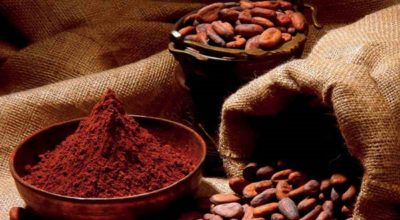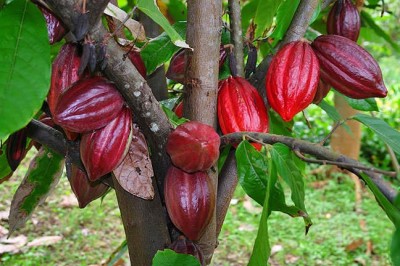 There must be 1,001 reasons why cocoa is called “the food of the gods.” From the time this super-food was first consumed – archaeological studies date it back to 17-19th century B.C. — up to the present, cocoa has been prized all over the world as a rich, delectable beverage, a medicine, an aphrodisiac and a flavorful ingredient added to snacks and desserts.
There must be 1,001 reasons why cocoa is called “the food of the gods.” From the time this super-food was first consumed – archaeological studies date it back to 17-19th century B.C. — up to the present, cocoa has been prized all over the world as a rich, delectable beverage, a medicine, an aphrodisiac and a flavorful ingredient added to snacks and desserts.
In Mexico, Central and South America where it was first cultivated, Mayans and Aztecs believed the plant to be of divine origin, a gift from their creator. Cocoa beans (or seeds) were so highly esteemed that natives used them as currency, and to pay tribute to their chieftains.
In the 1500s, after Dominican friars got wind of cocoa’s value and brought seeds back to Spain, it gained popularity as a medicine and aphrodisiac, aside from a luxury drink afforded only by the Spanish and Portuguese elite. A century later, it found its way to England where chocolate houses soon opened and cocoa surpassed the popularity of coffee. It wasn’t until 25 years later, in the 18th century, that cocoa became acknowledged and prepared as food.
Multi-billion dollar industry
It was a Swedish botanist, Carl Linnaeus, who classified cocoa and renamed it Theobroma Cocoa (“theo” being Greek for “god” and “broma” derived from the Latin “brosi” meaning “food”). Obviously he recognized its “off-the-charts” value and paid homage to what the Mayans and Aztecs first believed about it.
The Amazing “Aztec Super-Food” Used By Top Survivalists For Mission-Critical Strength And Endurance!
In the 1800s when technology was developed to separate cocoa butter from the dried beans, it led to the manufacture of solid chocolate. When the Swiss introduced milk chocolate processing late in that century, it started a worldwide multi-billion dollar industry that it has become today. Cocoa is now grown in 58 countries and contributes more than $4 billion to the world economy yearly.
Theobroma cocoa is a small evergreen tree that grows about 15 to 25 feet in humid, tropical climates. Its red-orange, sometimes purplish fruit, usually around 4 to 12 inches long, contains about 20-60 beans embedded in a soft, white pulp. The beans are the ones used to produce cocoa which, when processed, becomes the basis for different kinds of commercial chocolate.

Image source: Cocoa plant
Here in the Philippines where it grows abundantly — thanks to the Spaniards who brought and planted them here when the islands were under their rule – cocoa is enjoyed several ways. The sweet, fleshy pulp is eaten raw, while the beans are roasted, ground and molded into either balls or tableas, or flat circular tablets used in preparing hot cocoa and champorado — a chocolate porridge made with sticky rice, water, tablea, sugar and milk.
For most people living outside regions where cocoa thrives – which are countries only within 20 degrees north or south of the equator – raw, unprocessed cocoa isn’t easily available. Many have to just do with chocolate or cocoa products, which are cocoa beans that have gone through the “Dutch” processing method of alkalization. After being refined, cocoa products in the form of powder, liquor, morsels, bars and syrups are usually added with sugar (lots of it), milk solids and other additives to improve taste and prolong shelf life. These are what are normally used in baked goods, candies and desserts. Most of them contain less than 50 percent cocoa, and since they’ve been processed, carry only trace amounts of the phytonutrients that cocoa is known for in its raw, unadulterated state.
Do you like dark, unsweetened chocolate? Then your palate has made the better choice because bitterness is a good indication of how raw cocoa is. In the US, many health and specialty food stores now sell raw cocoa in powder form, or small broken pieces called nibs, or even as whole beans. These were dried at only low temperatures so they’re probably the closest you can get to eating cocoa raw.Try tasting some nibs, you’ll find them very bitter. But sprinkled on smoothies, yogurt, granola, cookies and desserts, they’re fantastic!!
Health benefits
As early as the 16th century, publications about the medicinal benefits of cocoa were already present. It was used for treating fever and dysentery, improving heart, kidney and liver strength and improving longevity. Petals from the flower were used to treat skin problems, burns and stomach ailments. Today, countless studies continue to appear in medical journals extolling its healing properties.
Story continues below video
Most notable among them is cocoa’s ability to promote cardio-vascular health. Cocoa beans are packed with anti-oxidants in the form of polyphenols. Compared with other anti-oxidant-rich foods like blueberries, goji berries, acai berries, prunes and grapes, red wine, and green and black teas, cocoa is said to have the highest levels. It is actually reported to have up to four times the amount of antioxidants found in goji berries and green tea. Polyphenols in the form of flavonoids and cathechinsalso help dilate blood vessels, inhibit blood clots, improve circulation, regulate blood pressure, lower bad (LDL) cholesterol and increase the good ones (HDL), thereby reducing the risk of stroke and heart attacks.
The oft-quoted Zutphen study of elderly men published in Archives of Internal Medicine in 2006 revealed that subjects who ate cocoa had lower blood pressure than those who didn’t. Those who consumed the most were also found to be 50 percent less likely to die from cardiovascular disease, and 47 percent of any other disease.
Flavonoids are known to protect the body from environmental toxins by battling and removing free radicals in our cells and tissues, and help repair any damage caused by them. This is why flavonoid-rich foods like cocoa have the ability to reduce the risk of cancers, or else fight it when the disease is already present. These same antioxidants are also responsible for preventing and treating allergic diseases, promoting insulin resistance (thereby reducing risk of diabetes) and reducing inflammation associated with arthritis.
Cocoa is known to promote the activity of neurotransmitters in our brains that are responsible for our moods, thought patterns, states of alertness and focus. It stimulates the secretion of serotonin, which helps to battling depression, and the release of endorphins which produce a pleasurable sensation in us similar to “runner’s high.” It also increases our existing levels of phenylethylamine (PEA), an adrenal-related chemical that quickens the pulse rate and causes us to feel upbeat and elated. PEA is also associated with high levels of wakefulness and the ability to concentrate better.
Have you heard of the “bliss chemical” anandamide? It’s a lipid which causes us to feel great. Cocoa not only contains this, but also has N-acylethanotamines, which increase levels of this already existing “happy substance” in our brains and causes us to feel excited. It uplifts us without making us addicted like caffeine does, nor does it have side-effects like amphetamine does.
Cocoa contains an impressive array of over 300 compounds: carbohydrates, healthy fats, fiber and various minerals– magnesium, sulphur, calcium, iron, zinc, copper, phosphorous, potassium and manganese. Cocoa is one of the top food sources of magnesium. It is important for brain, nerve and muscle function, builds strong bones, keeps heart rate steady and regulates blood pressure. Magnesium deficiency, present in 80 percent of Americans, is linked with hypertension, heart disease, diabetes, joint problems and pre-menstrual tension. Sulphur detoxifies the liver and is known as the beauty mineral — it promotes healthy skin, nails and hair.
A one-ounce serving of cocoa contains 9 grams of fiber, or 36 percent of the RDA. Adding as little as 6.6 grams of cocoa fiber to your diet everyday should keep your bowel movements regular, according to Dr. Michal Peluso, a nutritional biochemist.
How to grow cocoa
If you would like to grow cocoa outdoors, you must live in USDA plant hardiness zone 10 or higher. Hawaii is the best place, but it can also thrive in Southern Florida where it’s warm and humid — although any chance of a brief freeze or prolonged cool can damage the plant.
Cocoa is a tricky plant to grow. Though it isn’t hardy inside temperate indoor environments, it IS possible to grow them, although you can expect problems and even fail at your first attempt. If you have a greenhouse that can replicate the hot humid rainforest environment in which it thrives best, then you have a higher chance of not only growing a plant but actually seeing some fruit.
Your first challenge would be finding good seeds, since these have an extremely short viability. Only those that have been newly or recently picked from the fruit are suitable for growing, so it’s better to obtain a fresh fruit. Old or dried seeds just won’t do. (You could try finding a supplier in Hawaii or Puerto Rico that can ship you fresh, ripe seeds overnight.) A better option might be to purchase a seedling, which has already been adapted to local conditions and toughened for growing in a pot. Ask your local nursery if they could source one for you, or check online dealers.
Remember, growing conditions must always be at a temperature of 65 to 90 degrees F and humidity of at least 60 percent. If you don’t have a greenhouse, use a humidifier and heater to approximate tropical conditions. You could also use an adjustable growing lamp with a filter to provide warmth, or put a plastic bag or tent over your seedling. Set a bowl of water next to it to release humidity. Cocoa likes rich, moist, but not overly wet soil, so spray sparingly but often. Mulching would help keep the earth moist longer, too.
Cocoa is an understory plant, and it does best under indirect, filtered sunlight. Find a spot under the canopy of tall, overhanging trees where it can receive partial or about 25 percent shade.
Barring any major problems, you can expect your plant to flower within 4-5 years. Naturally, though, flowers are pollinated by midges — tiny flies that thrive in the thick, damp vegetation — so without these you’d have to pollinate the flowers yourself by hand. If fertilization is successful, you should be able to see fruit within 5-6 months.
Have you ever grown cocoa, and do you have any tips? Let us know in the comments section below.
Sign up for Off The Grid News’ weekly email and stay informed about the issues important to you
 Off The Grid News Better Ideas For Off The Grid Living
Off The Grid News Better Ideas For Off The Grid Living




